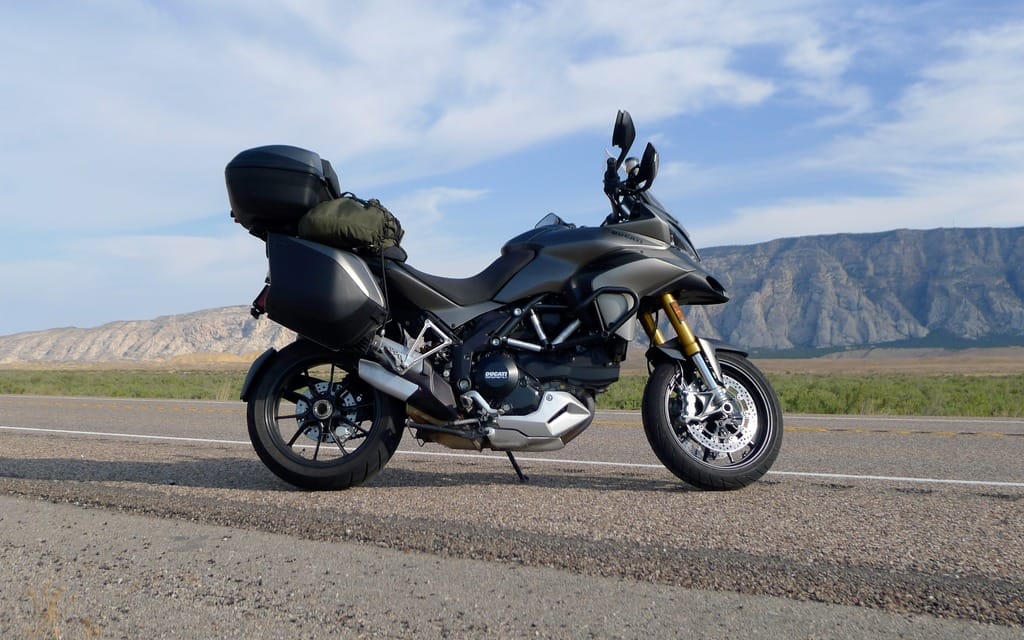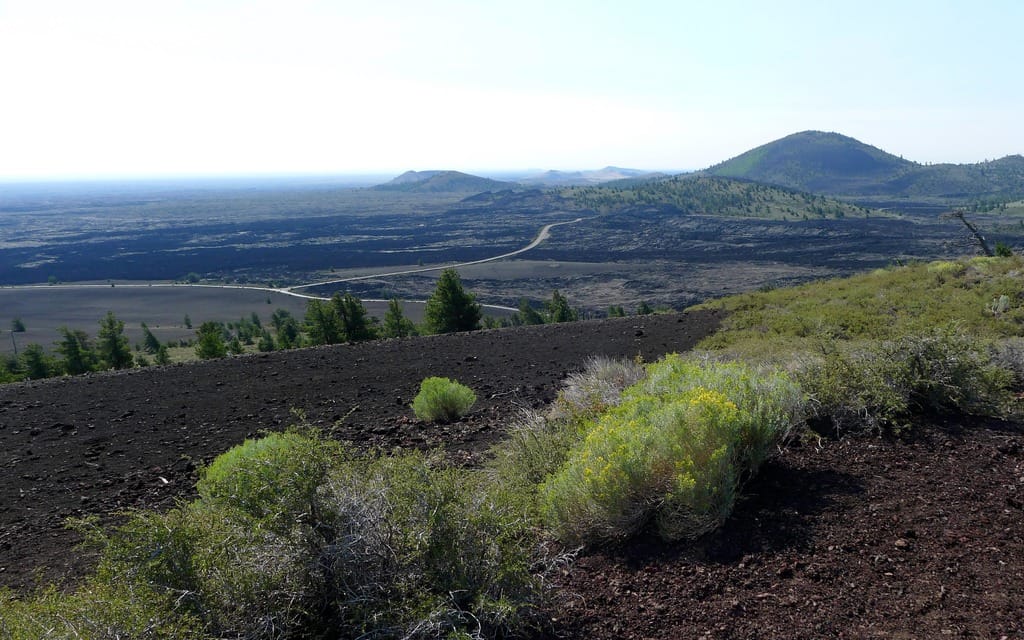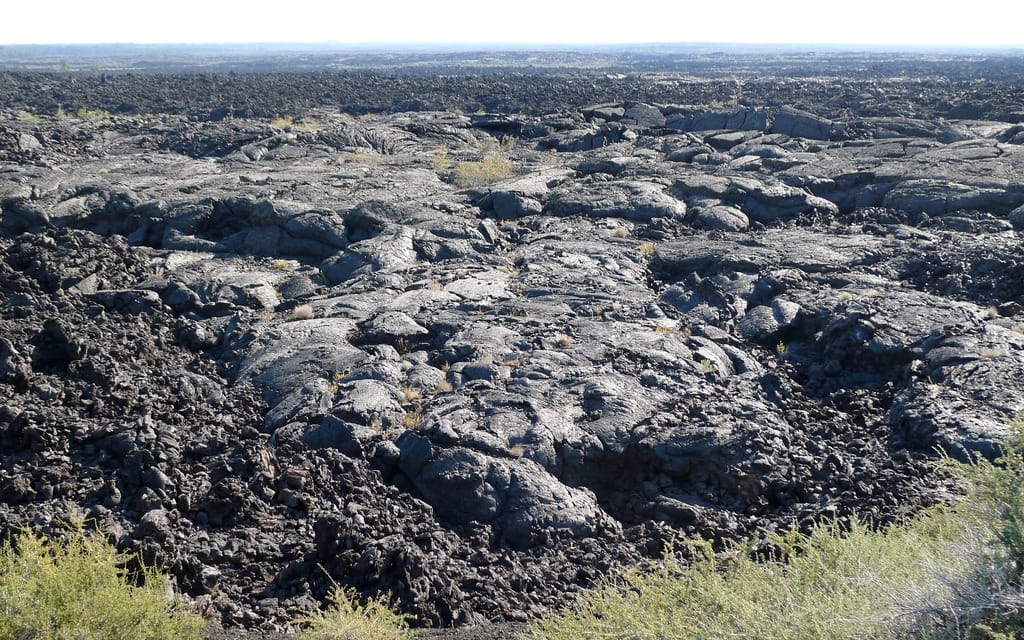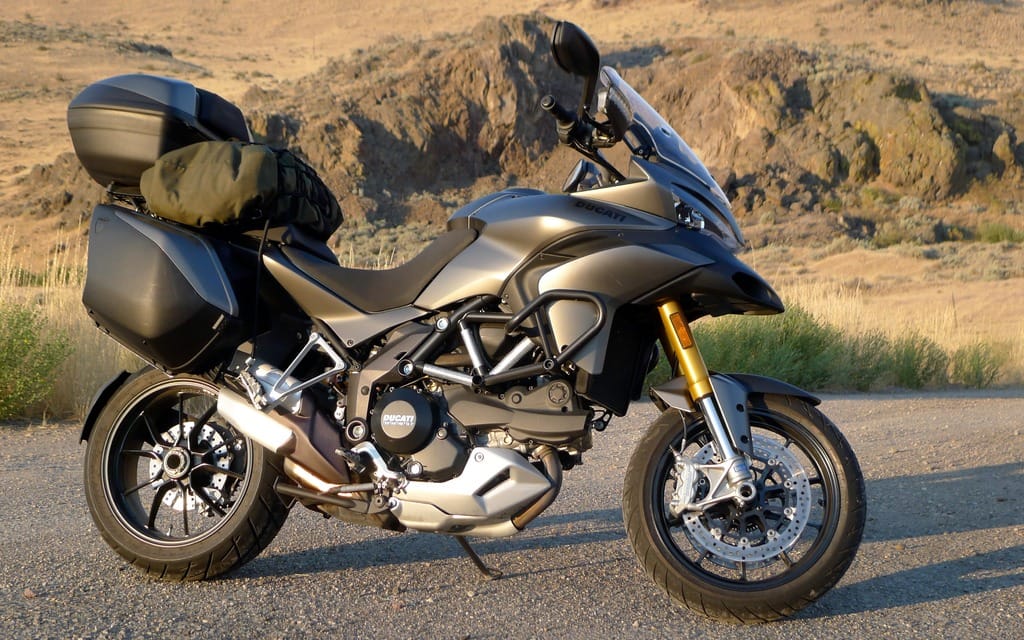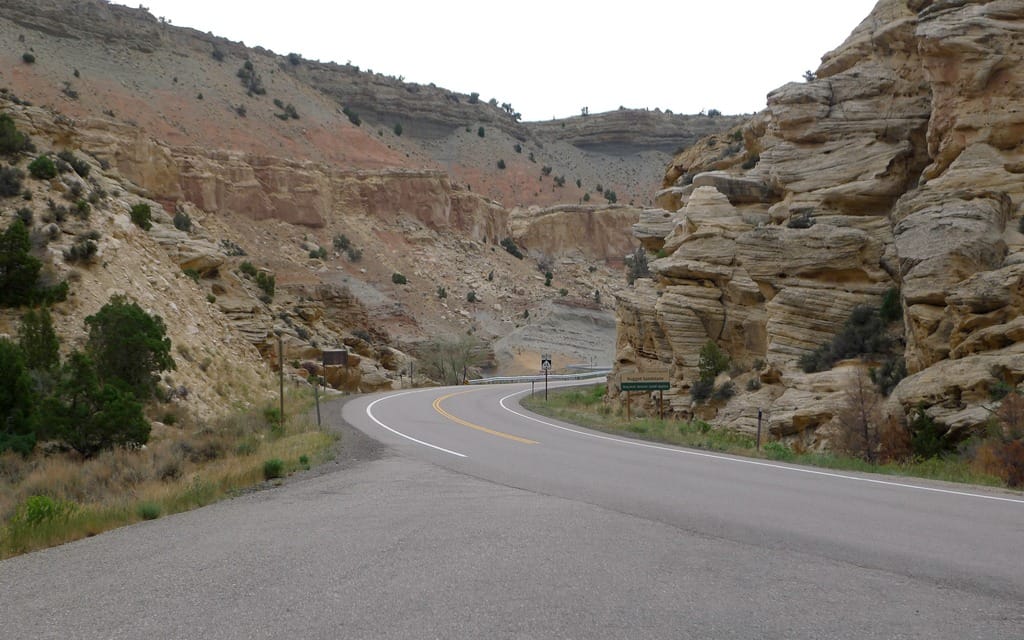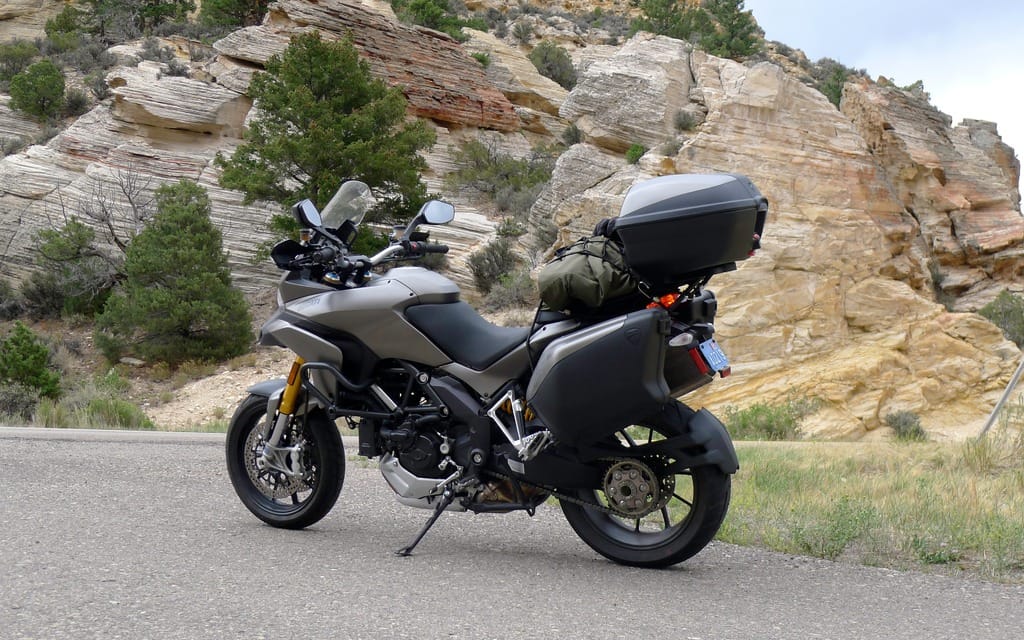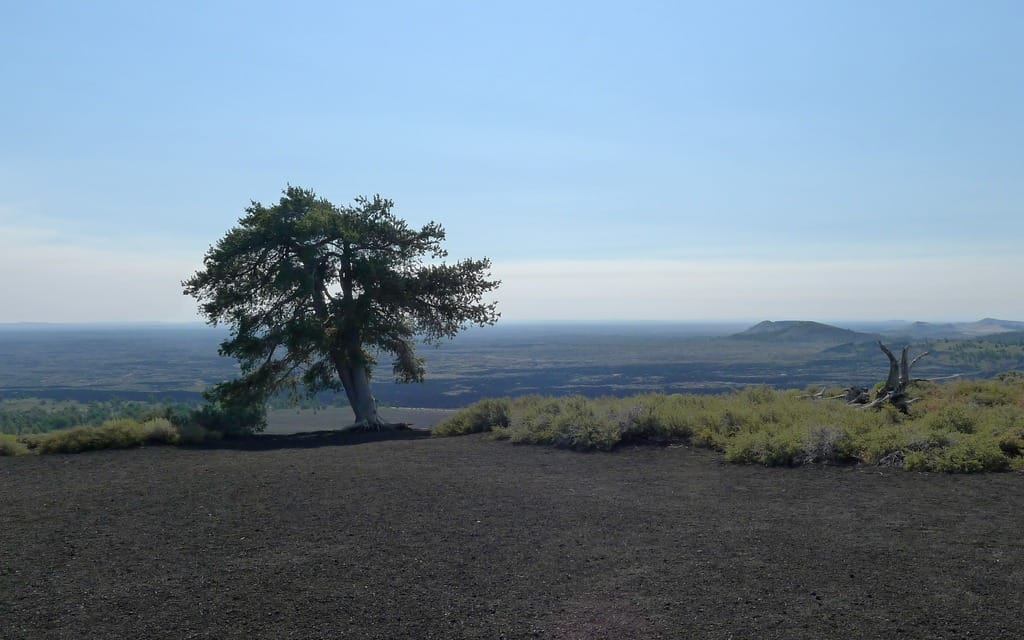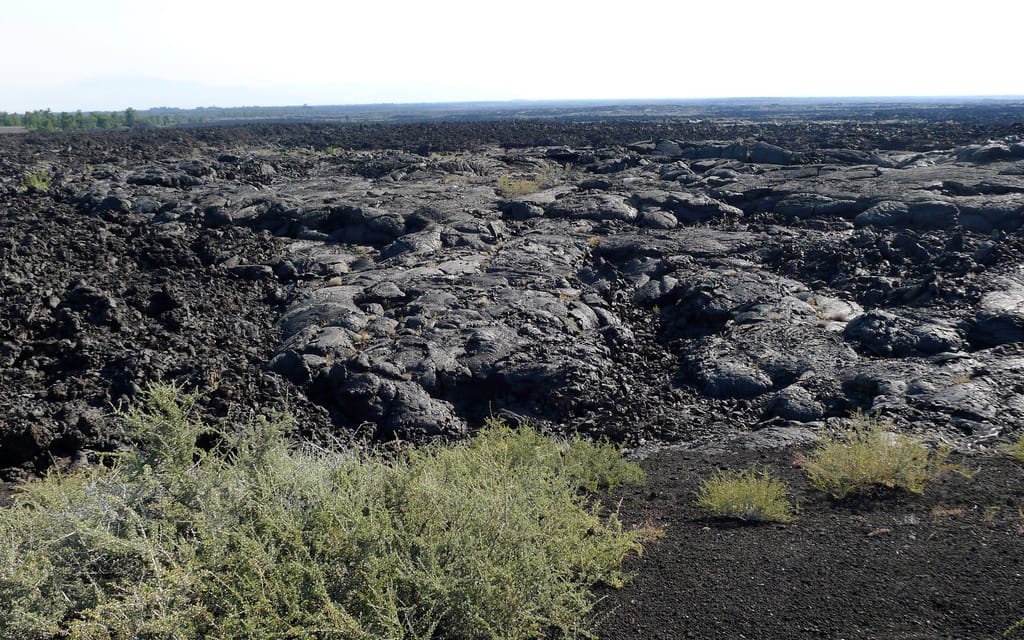Whole Lotta Lava
Tim Poupore gets baked on the road to heaven’s stairway
The road winds between parched hillsides on my right and the Columbia River on my left, sharing a narrow strip of land with fruit orchards that glisten with irrigated sweat. A road sign flashes an emphatic “No Stopping” command; then, incongruously, a second sign suggests that I “Be Prepared To Stop.” I so prepare. A third sign informs me that there are “Fire Workers Ahead,” and I round the next bend and come upon a blackened world.
Fire has swept over these hills so recently that stumps of trees still smoulder as crews drill jets of water into their roots. There is nothing to save except the valley downwind. Everything to my right is charred and black. On my left, Granny Smith apples reflect hard sunlight and glow a surreal and iridescent green, an orchard of fireflies in Hell.
It’s a stark contrast to the earlier part of my day. I had picked up the 2012 Ducati Multistrada S Touring at Vancouver BMW Ducati with the intent of riding it to the Pikes Peak International Hillclimb in Colorado. The race had been postponed from early July to mid-August as wildfires had threatened the venue. There was nothing in cool and cloudy Vancouver to prepare me for the heat and drought to come.
I had drawn a line on the map between dealership and destination and planned a squiggly route that included as many road types and as little highway droning as possible. The Multistrada’s schtick is “any road, any time,” and I wanted to test theory against reality. This of course saw me heading south out of Vancouver on straight-as-an-arrow Highway 99 and Interstate I5 through Bellingham, Washington. At Sedro-Woolley I left the interstate for Hwy 20 and its vaulting eastward romp. This is a fabulous stretch through the Cascade Mountains that has every clichéd Alpine road feature you can imagine: majestic firs, towering peaks, rushing waterfalls, and all the sweepers and hairpins you could want.
The climb up to the top of the Cascades is much more fun than the downside slope, and after about 200 kilometres the fresh trees and cool rock faces are replaced by the hot and arid Methow Valley, part of the Columbia Plateau which, like much of the States and Canada, has been experiencing severe heat and drought all summer. From single-digit temperatures cresting the range at Ross Lake the Multi’s on-board thermometer has climbed to 41° C by Wenatchee. How do you dress for a 30 degree spread? Coolant temperature peaked at 105° C as I crawled through town, but the engine never missed a beat. I, on the other hand, faced serious dehydration and had to stop for rest and cooling water.
Back at the burn site, 20 kilometres of fruit and devastation end and shrubland returns. The river bends and I cross a bridge and see two blocky white buildings across the plain to my left. A serious fence runs along the road with yellow warning plaques every few posts. This immense tract is the Hanford Nuclear Reservation and the blocky buildings are two of nine reactors that were built along this stretch of the cooling Columbia in the ’40s as part of the Manhattan Project. The closest building is Reactor B, which produced the plutonium that levelled Hiroshima and later contributed to Hanford’s creation of two-thirds of America’s nuclear waste. Still generating power, the site is also home to the largest environmental cleanup operation in U.S. history.
With 700 kilometres under me I stop for the night just south of Hanford in Richland, Washington. In a motel room, the shower works, the water out of the tap is good, and the lumpy bed is at least not the Multi’s seat. Don’t get me wrong, the bike is as comfortable as any I’ve ridden, but eight hours is eight hours. In a nearby coffee shop I tuck into a perfect steak, and later, nothing glows when I turn out the lights.
I start the next day with a run to Walla Walla, simply because it featured in the punch line of a joke my mother used to tell before looking at my father and dissolving into peals of laughter. I fill up with gas while reminiscing about a joke I never got in a place I’d never been. On the way I passed a vast wind farm of giant turbines perched on ridges and staggered back from the highway so their blades appeared to march over the horizon in a War-of-the-Worlds kind of way.
The two-lane highway from Walla Walla to Lewiston, Idaho, passes through pasture and farmland that has been rendered by drought into a tinder-dry condition. The land rises and falls in a series of brown gullies that the road follows in long left-right sweepers. This route is better than I expected and the Multi is in its element. All three cases are full and I’ve got a duffle bag strapped to the rear seat, load mode is set on Rider Plus Luggage, and the mapping is set on Touring, but my pace is brisk on this empty road. The only time the bike complains is in town where traffic slows. In stop-and-go traffic it requires a lot of clutch slipping or it starts surging and bucking. Switching the mapping to Urban reduces this behaviour to an almost acceptable level, but it still complains. If you’re looking for the Multi’s Achilles Heel, this is it.
Button-punching leads me to conclude the whole concept of adjustable electronic controls is a gimmick, and I hope a passing fad. Why should I have to switch modes when I come into town? Why would I want to? If an app on the phone in my pocket can tell when I change from highway droning to canyon carving to city start-and-stop, surely a Ducati can. Strangely, this bucking behaviour seems less pronounced in Sport mode than in Touring, which makes no sense, but it presents a delightful compromise of full power (which Urban lacks) with less surging. Bizarre. On the other side of town I crack the throttle and enjoy the rush of power simply because it’s there. All is forgiven.
When I get to Lewiston I head south again, and after a boring trek through brown farmland I arrive at a sublime high-speed canyon stretch that drops into White Bird, and then the road climbs up through wooded foothills by the Salmon River to a plateau at the base of the Rocky Mountains. I cross the Snake River upstream of Evel Knievel’s crash site and enter Oregon just long enough to fill the tank and rehydrate. I chat with a couple in soaked tank tops and bandanas who’ve just ridden over the bridge from Idaho behind me. Their grilled shoulders look like bratwursts ready to pop.
I haven’t seen a cloud since I crossed the Cascades, and heat continues to be an issue. I see 39° C on the dial and water is always on my mind. The modest windscreen on the Multi offers just enough adjustability to choose between letting the hot wind wick away sweat and passing the flow over my head. Buffeting is minimal regardless of position and seems to be affected more by the wind’s angle of attack. I find the screen easy to adjust at speed, though I’m sure Ducati doesn’t recommend that.
Mountain Home, Idaho, is just southeast of Boise and has a few places to choose from so that’s where I stop, 813 kilometres from where I started this morning. I find a passable hotel right at the exit for Hwy 20, which is tomorrow’s route to Craters of the Moon National Monument, and I end my day there by washing the bike in the shade.
Day Three starts before sunrise. I want to take pictures of the bike on these plains in early light, and near Soldier Mountain Game Preserve I find a few photo spots off the highway, but that’s about as far off-road as this motorcycle is going to get in my hands. With dusty soil and street-skewed tires it’s easy to invoke the Ducati Traction Control system. The Multi weighs well over 200 kg laden with all my gear and I have no desire to drop it or wedge it in an arroyo.
After the game preserve I’m onto a straight run with a single left turn in Carey before arriving at Craters, a weird National Park replete with volcanic cinder cones, spatter cones, and convoluted lava flows known as the Devil’s Vomit that stretch for 60 kilometres in all directions. Thinking I might find some interesting terrain to illustrate the Multi’s capabilities, I’m disappointed to find freshly paved, billiard ball smooth trails and a 25 km/h limit. I snap some pictures and get back on the road.
The secondary roads that make up most of my route are almost devoid of traffic, and while I’ve traversed several stretches with broken and pockmarked pavement, most of the surfaces have been well maintained. This Multi is fitted with optional, electronically adjustable Öhlins suspension, which gives me nothing to complain about, except that again I have to choose and push buttons. The ride is compliant and comfortable on long touring stretches and more than capable of handling anything I throw at it in the twisties. There is considerable dive under braking, even in Sport mode, but while there’s no mistaking this for a sportbike, it’s not out of character for a big dual-sport. I imagine the base-model’s Sachs suspension would be sufficient even in my most aggressive moments, but there’s no mistaking the Öhlins cachét.
By midday the heat is back with a vengeance so I stop for lunch in Pocatello, Idaho, then head southeast to Kemmerer, just over the border in Wyoming, where the tourism slogan “Like no Place on Earth” is hard to argue with, even after Craters.
The southwest corner of Wyoming is a hardscrabble place where signs of habitation are few. There was a time when taking any motorcycle through such wilderness represented a considerable risk, but I never once considered reliability when planning this trip. A more realistic probability is that I am so inept at planning that I will run out of gas. My wife would tell you that I am indeed capable of this. I ride for many, many miles without seeing a single gas station and am glad that the Multi’s fuel light comes on early. When it does, I still have 160 kilometres to go before things become dire, and so I continue my trek through territory marked “Open Range.” This is an interesting concept, meaning “land so vast fences aren’t worth the trouble.” The risk of coming over a rise to find a herd in the road is real, and the only living things I see for miles are a few head of cattle standing in a dried creek bed wondering where the water has gone. They and I need refreshment, and the bike is thirsty, too. When I finally do find gas, I appreciate the Multi’s range of some 350 real-world kilometres.
The heat has not been quite as untenable as in the previous two days, but it’s still in the mid-30s even with clouds gathering overhead. As I fill the bike I look southeast and see a massive storm brewing with angry black cloud cascading to the ground. Exactly where I’m headed. Rain would be refreshing but I don’t want to get drenched, so I get into my rain suit. A few minutes later, the highway changes course and I am shuttled around the storm. I wonder how roads know to do that.
I cross the border into Utah, turn south at the village of Manila, and descend into a spectacular canyon at the Flaming Gorge National Recreation Area. The only part better than dropping down into this beautifully eroded gully is riding the switchbacks up and out the other side. At the top I’m in the scraggly pine of the Ashley National Forest, which is again open-range territory peppered with roaming black cattle. The storm I missed has been here but the roads are drying fast and I sweep through with only a minor holdup in the form of a short conga line of RVs and work trucks. Rush hour in Utah is not a problem on the Multi but the impatient guy in the diesel duelie in front of me is. Each time there’s an apparent break he drops his pedal and tries to overtake. Every time he backs off and I get to ride through his thick black cloud of particulate. I’ve had enough and I make my move, getting past everyone easily in two quick stages.
My timing is perfect as the run down the far side of this ridge starts immediately after I pass the leading RV. Yet another series of switchbacks has me seriously considering turning around and doing the road again, but it’s been a long day. After a short ride I enter Vernal, Utah, my intended destination after a ride of 891 kilometres. I check in to a motel on the main drag with a dozen festive Harley dressers sprawled in front of their rooms. Most of the bikes I’ve seen on this trip have been Harleys, likely headed for the Sturgis rally. But I also see a squadron of BMWs, neatly lined up on their centrestands and efficiently sharing a single parking spot. As I walk down the road to find another steak it occurs to me that I haven’t seen a Ducati the whole trip, and just then a Pikes Peak Multi burbles by. As I stroll back after dinner, dark clouds try hard to make a shower. I can see rain falling but in this heat, most of it fails to reach the ground.
Friday. I have to get to Colorado Springs today, but I don’t want to rush it and miss good roads. Main Street in Vernal becomes Hwy 40, which continues over the border into Colorado just a few miles down the road. Fifty-five kilometres into the ride I come to Dinosaur National Monument. Unfortunately the visitor’s centre just off the highway is merely the gateway to the real facility. Anything worth seeing is a 60 kilometre ride north and I can’t justify the time. Walking back to the bike I see animal tracks in the concrete path and with feigned seriousness ask an elderly guide what kind of dinosaur made them. With the patience of a seasoned interpretive centre professional he explains that these are actually not fossilized dinosaur tracks but merely evidence of ground squirrels that ran around shortly after the paving crew left a couple of years ago.
Hwy 40 leads slightly north through foothills to mountains and Colorado Hwy 34, which appears in Google Maps to be a very squiggly road. Things are not always what they seem. I should have noticed that Hwy 34’s 80 kilometre length plus 90 minute time reference equals a speed limit of about 50 km/h. It isn’t until I reach the gatehouse that I realize squiggly Hwy 34 runs through Rocky Mountain State Park. It’s a Friday in August, and ahead of me are tour buses and cars filled with people who apparently have never seen an antler.
As compensation, when I finally leave the park and get back onto routes that are both squiggly and less occupied, I’m led along a wonderfully undulating stretch called Coal Creek Canyon Road that is marked by signs reading “Motor Cycles Use Extreme Caution.” Of course they do.
I skirt Denver, then shoot south to Colorado Springs, where I find my hotel with dozens of Ducatis parked in the lot, ready for Saturday’s Ducati Fan Ride to the Clouds.
Today’s 757 kilometres bring my trip total to 3,158 over four days and nearly 32 hours in the saddle. I’ve spent $140 U.S. for 140 litres of premium fuel, excellent fuel economy for such a tempting throttle. The Multi has carried me baked, broiled and steamed over all of the road types it is meant to travel, but the surface least tested is what has me questioning its conceit. Would I take this flashy $25,000 sport tourer for an off-road thrash if it were mine? Not likely, and certainly not on these tires. Buy a Multi and you won’t be disappointed; it will carry you with grace and style and delicious power on any road you care to travel. But if you also want to go off-road my recommendation is to skip the S-package and use the leftover coin to buy a used dirt bike weighing half as much. Of course, now that the Pikes Peak Highway is paved from top to bottom, perhaps the point is moot — here, anyway. After four days of hot riding on a fabulous bike I shower, eat, and fall asleep with that one road left to test. Tomorrow, I will ride to the clouds. At 14,110 feet of altitude, it will be cooler at the top.
